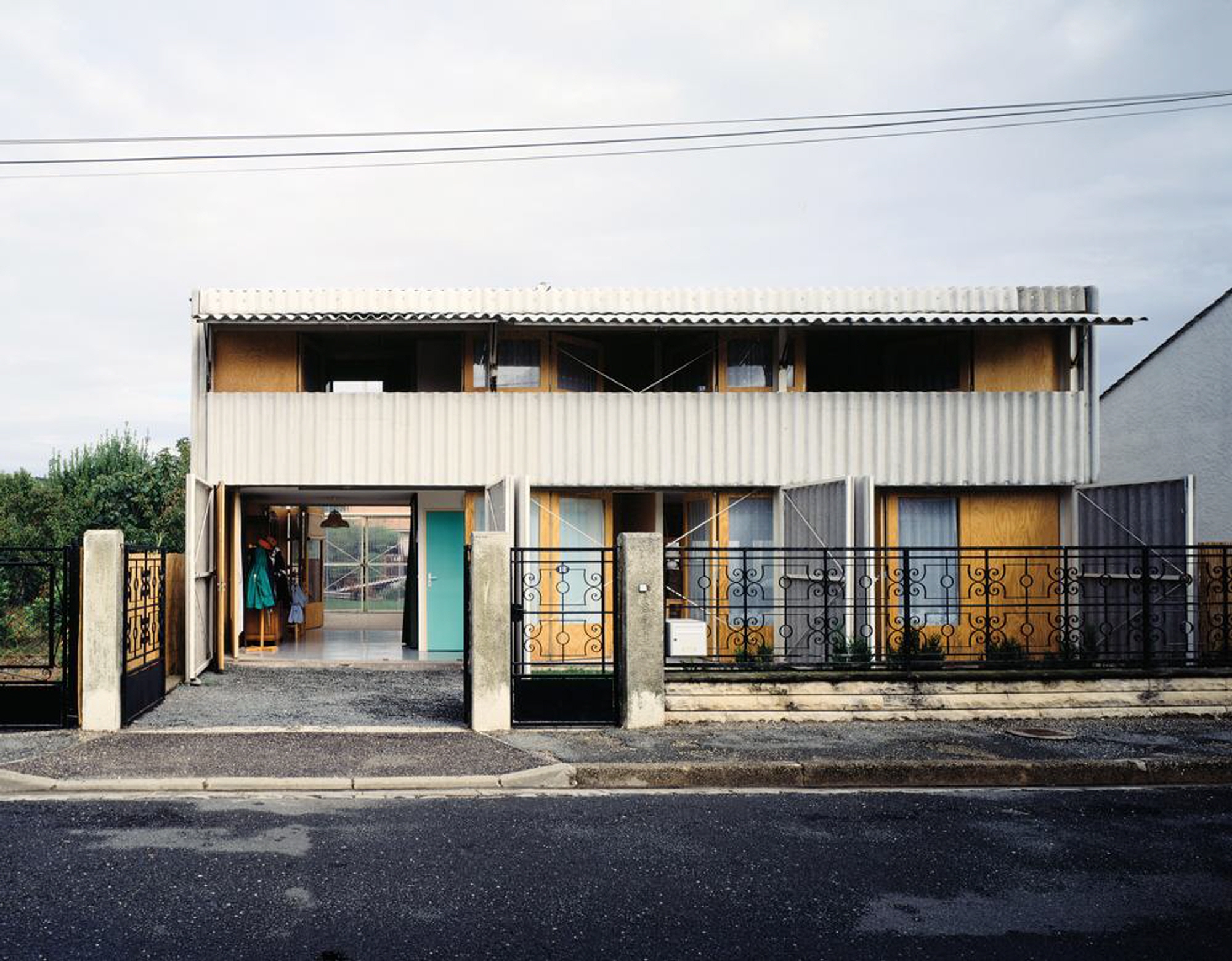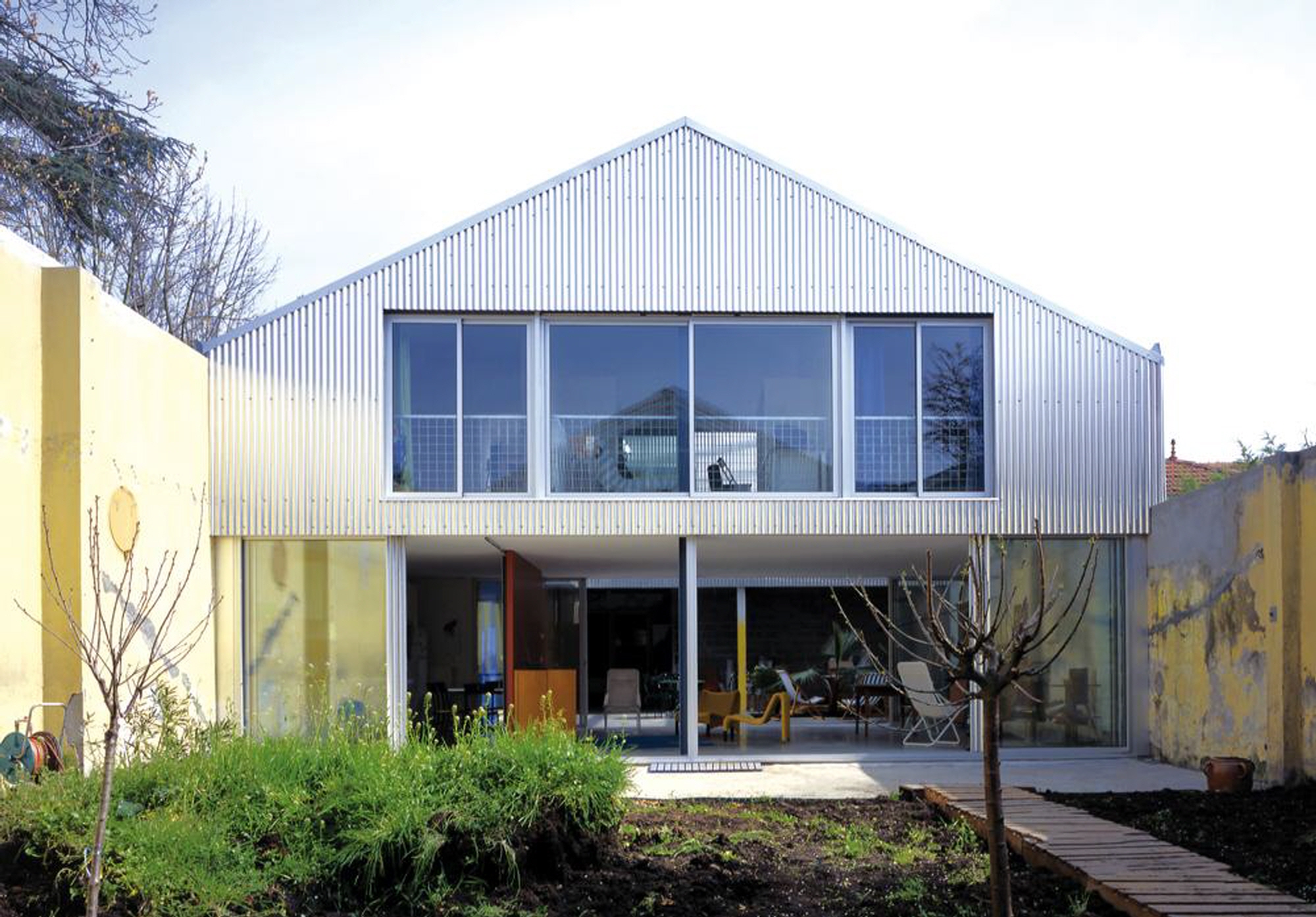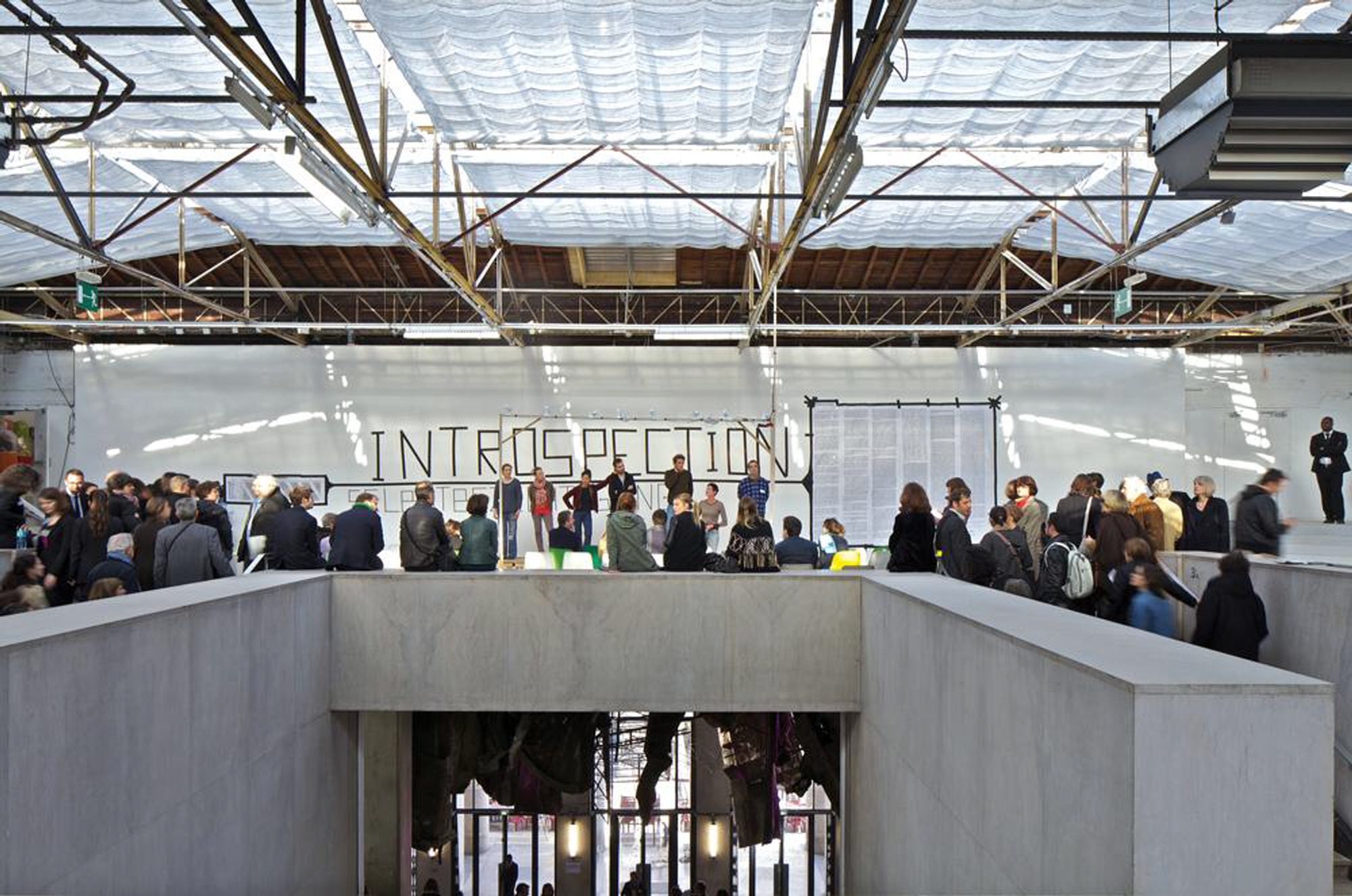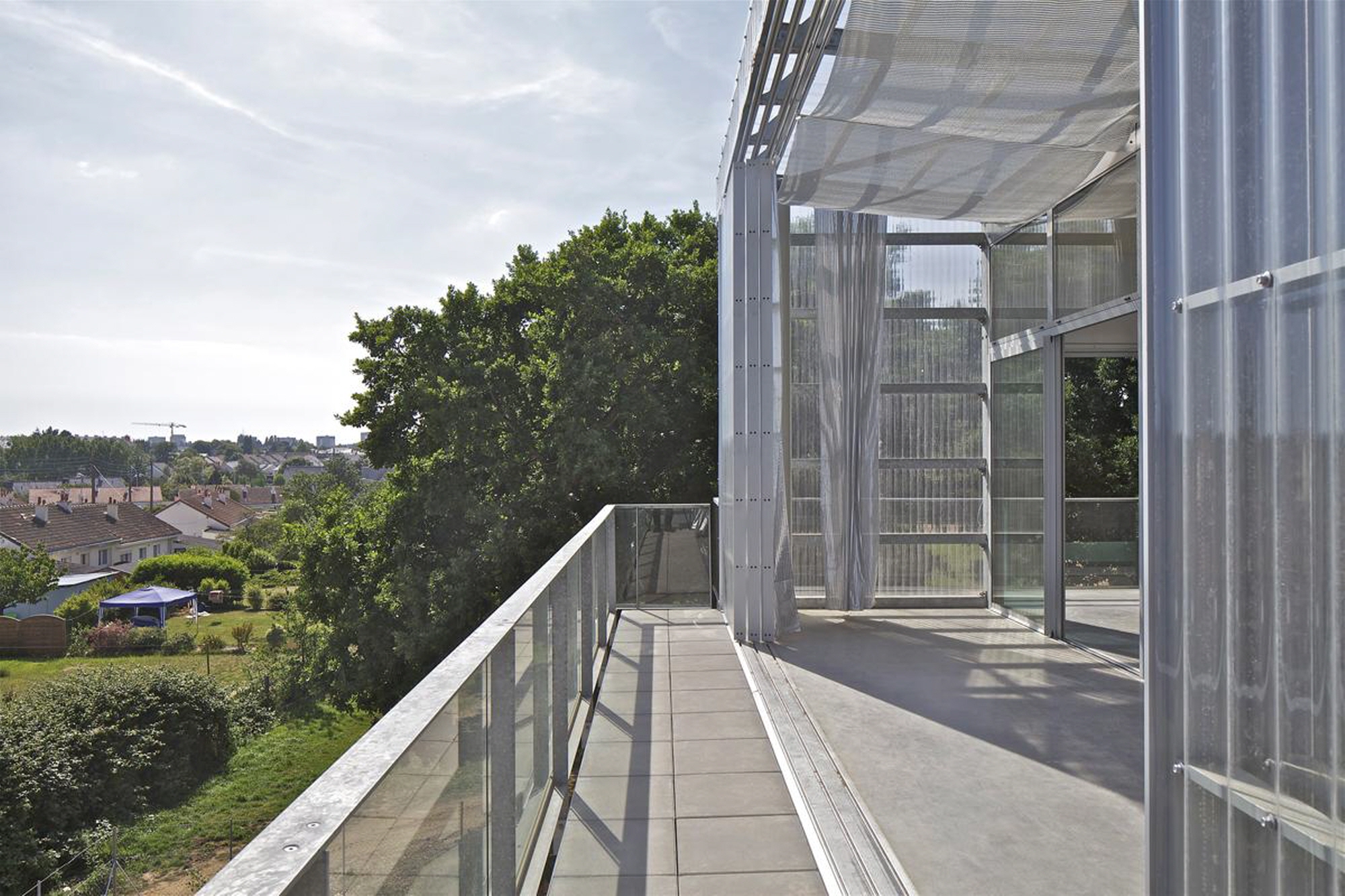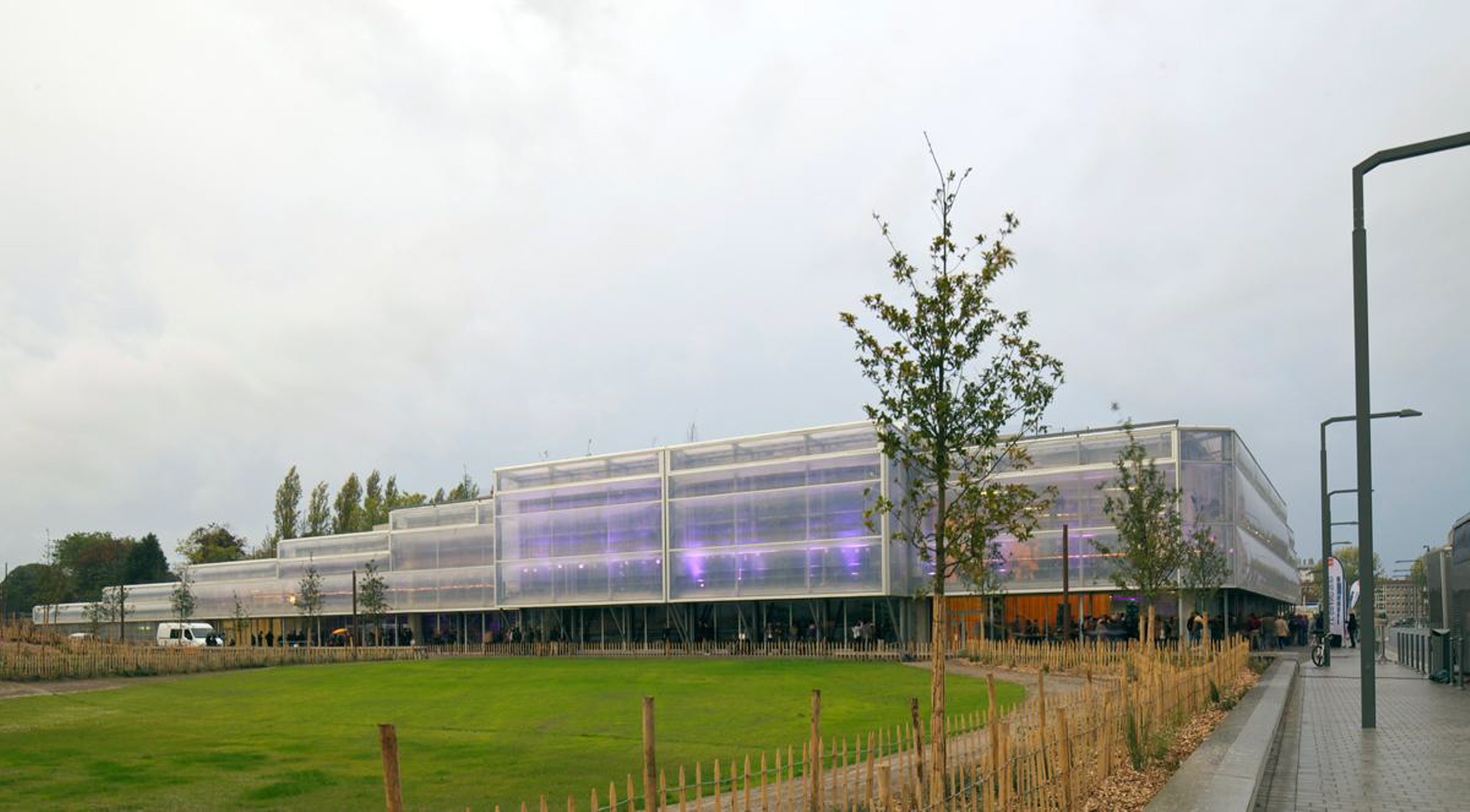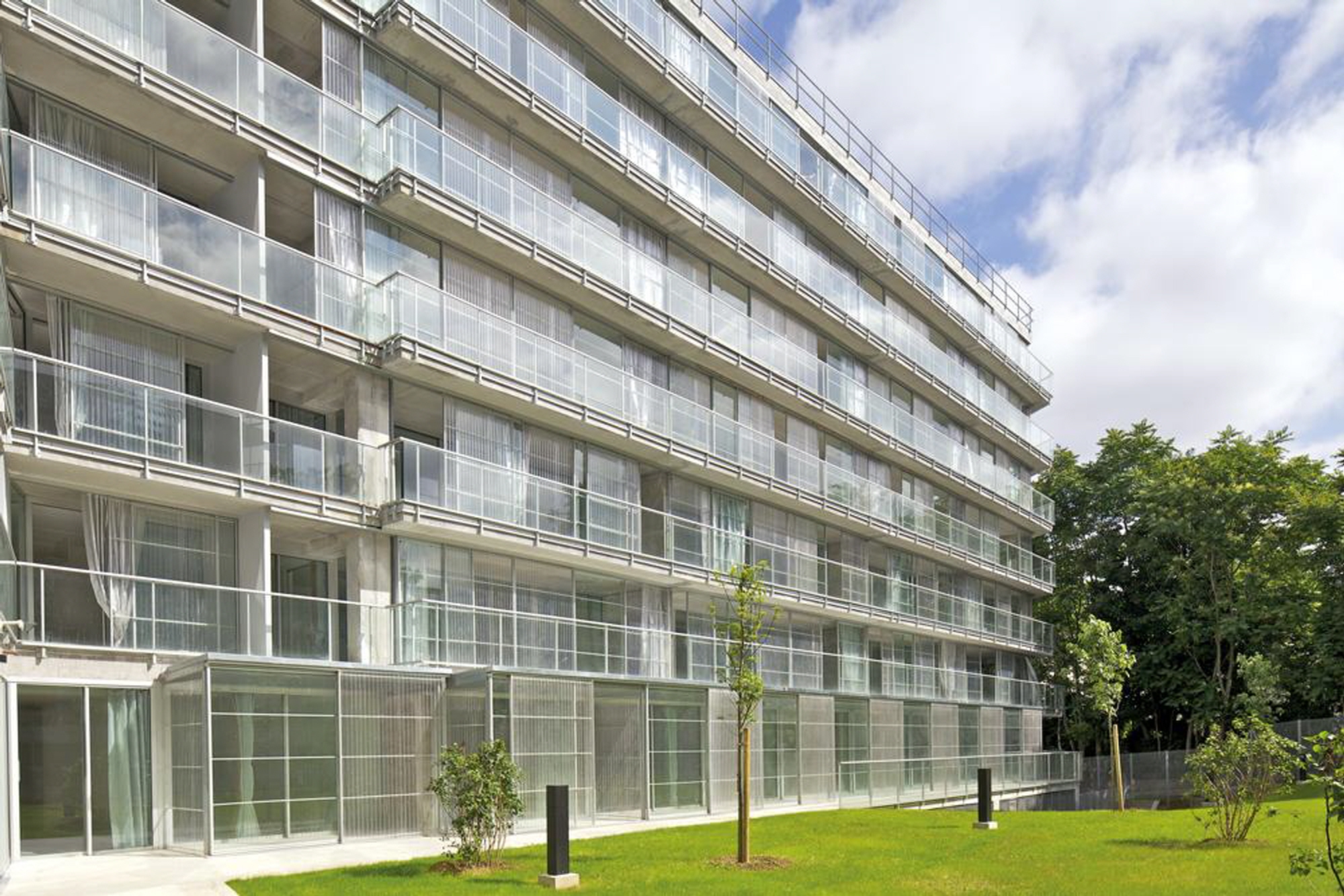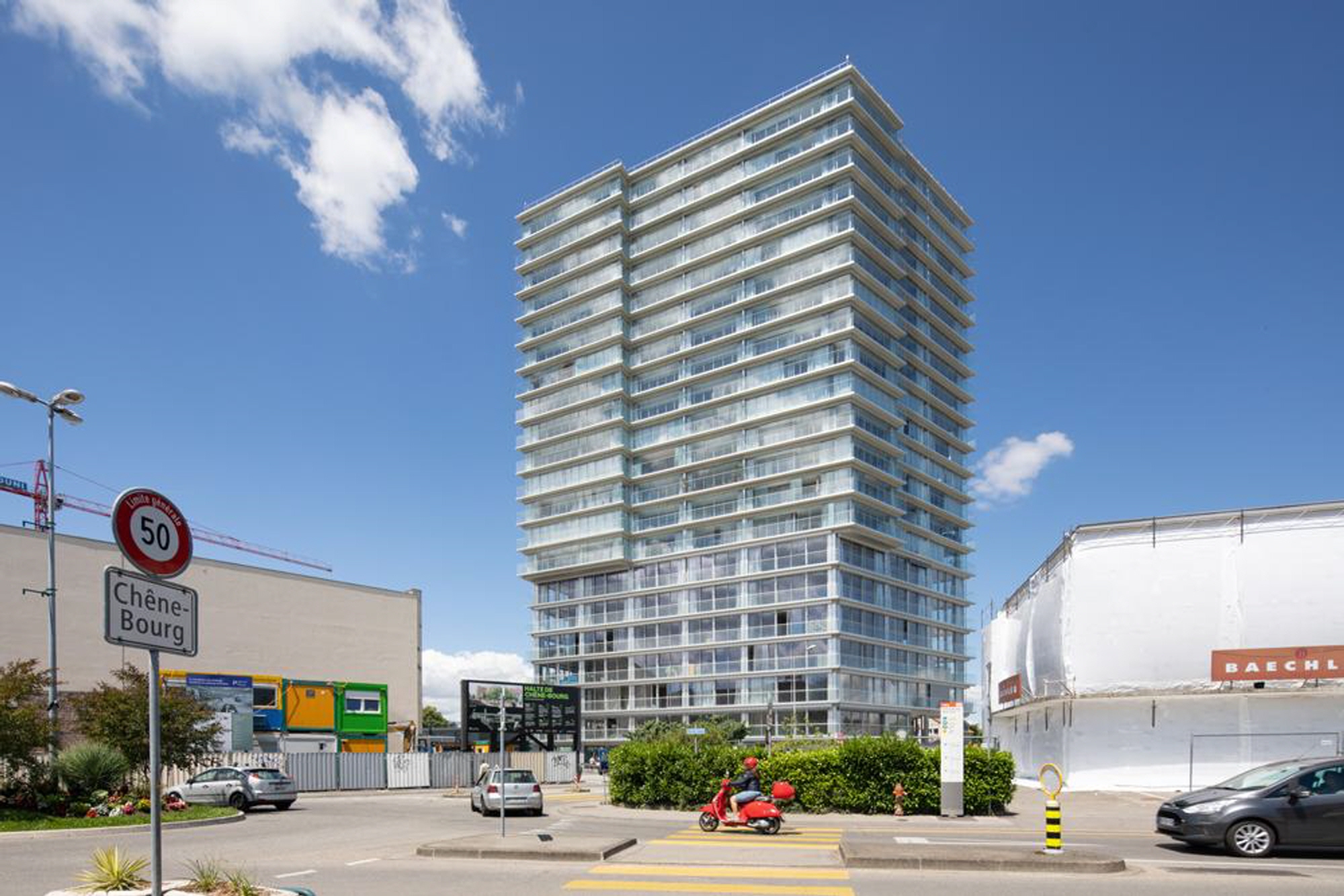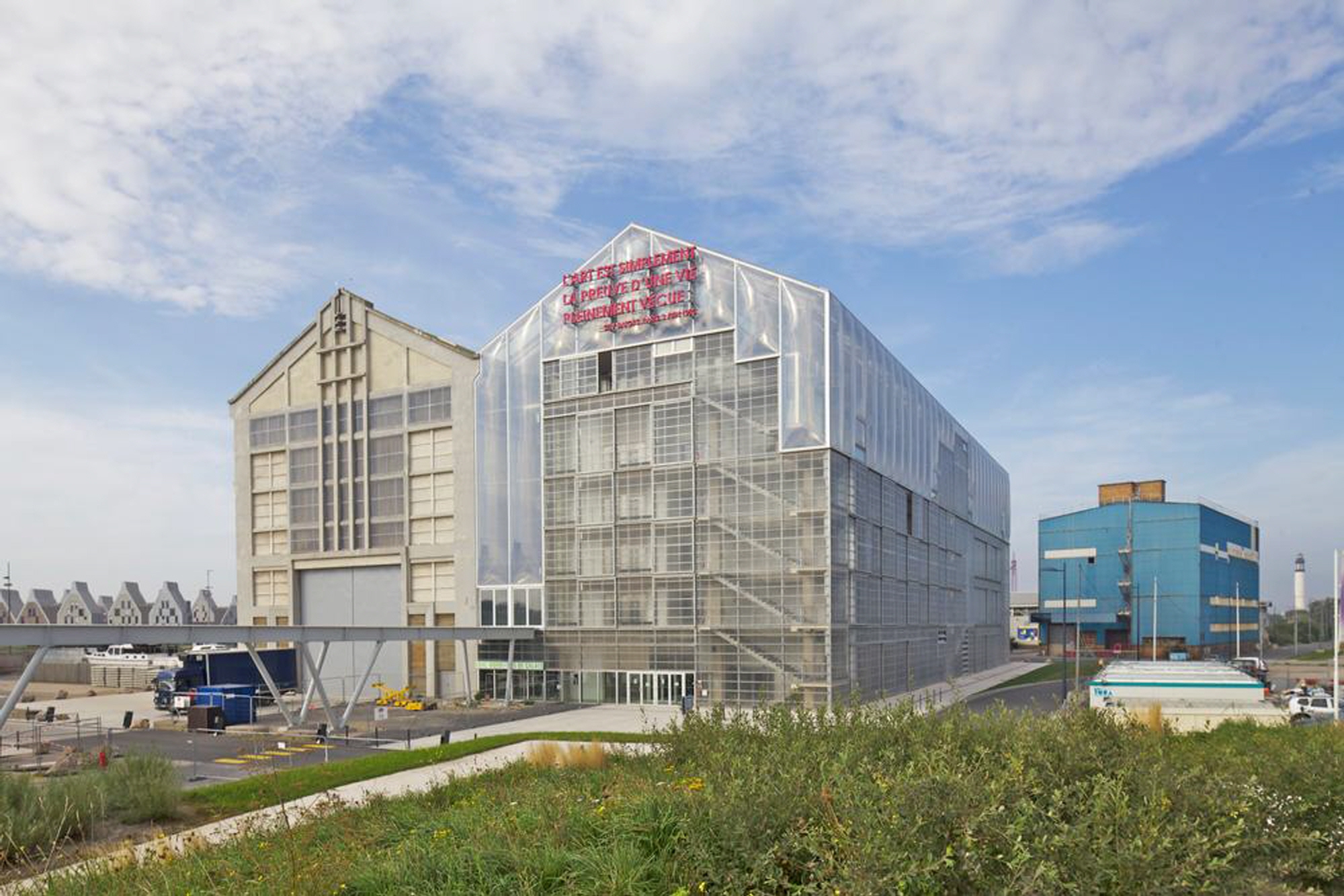AD
● 멋진 세상 속 건축디자인_ 2021년 프리츠커상에 안네 라카톤과 장 필리프 바살 두 건축가가 최종 수상자로 선정 Anne Lacaton and Jean-Philippe Vassal Receive the 2021 Pritzker Architecture Prize
“기존 건물을 절대 허물지 않고 설계한다”는 지속가능한 건축에 대한 신념을 실천해온 재건축과 리모델링 분야의 재능 많은 건축가
사진_ Latapie House, photo courtesy of Philippe Ruault
건축계의 노벨상이라고 불리는 최고의 영예상인 2021년 프리츠커상에 프랑스의 안네 라카톤과 장 필리프 바살 두 건축가가 최종 수상자로 선정되었다.
파리 외곽 몽트뢰유를 기반으로 활동하는 안네 라카톤(65)과 장 필리프 바살(67)은 재건축과 리모델링 부문에서 탁월한 재능을 보여주는 건축가로 정평이 나있다. 두 건축가의 대표적인 작품인 라타피 하우스(Latapie House, 1993)는 투명한 접이식 폴리카보네이트 패널을 활용한 온실 기술을 주택에 저렴한 예산으로 반영함으로써 풍부한 자연광을 끌어들였으며, 실내 공동 공간을 확장시킨 에너지 절약형 건물로 평가된다.
사진_ House in Bordeaux, photo courtesy of Philippe Ruault
사진_ Site for Contemporary Creation, Phase 2, Palais de Tokyo, photo courtesy of Philippe Ruault
이들 두 건축가는 “우리의 작업은 정해진 제약과 문제를 해결하고 효율적인 이용과 감정의 폭을 넓히는 차별화된 공간을 찾는 것이다”고 자신들의 작품세계에 대해 밝혔다. 이들이 새롭게 구현해 낸 파리의 미술관을 개조한 팔레 드 도쿄(Palais de Tokyo, 2012) 역시 1937년 파리만국박람회가 열릴 당시 사용되었던 오래되고 비효율적인 곳이었다. 여기에 건축가는 자신만의 기준으로 정한 합리적인 잣대로 기존의 공간을 재조정함으로써 공간의 면적을 확장하고 건물의 수명을 획기적으로 연장시킴으로써 혁신적인 공간을 창출해냈다. 건축가는 부분적으로 새로운 지하 공간을 만들어 2만㎡ 면적을 넓히는 동시에 사용자의 경험을 보존하는 효율적인 방식을 시도한 것이다. 파리 근교의 부아르프레트르 아파트는 기존의 콘크리트 파사드를 없애고 각 세대에 발코니와 큰 창을 설치하고 신축성 있고 유연한 확장 공간을 이끌어내었다는 점에서 좋은 평가를 얻었다. 이러한 건축가의 차별화된 프레임 워크는 530가구로 구성된 보르도의 그랑파크에서 주거단지의 극적인 공간 재창조, 엘리베이터와 배관시설의 현대화, 거주자의 퇴거 없이 공사하는 리모델링 방식, 저렴한 비용과 공간의 확장 등에서 참신한 건축언어로 발현된다.
사진_ 53 Units, Low-Rise Apartments, Social Housing, photo courtesy of Philippe Ruault
사진_ 129 Units, Ourcq-Juarès Student and Social Housing, photo courtesy of Philippe Ruault 2
사진_ Multipurpose Theater, photo courtesy of Philippe Ruault
프리츠커상의 심사위원단은 “라카톤과 바살 건축가는 현 시대의 심각한 기후변화와 생태학적 위기 상황에 부합해 모더니즘의 유산을 새롭게 하는 건축적 접근법을 정의했을 뿐만 아니라,섬세하면서도 급진적이고 대담한 작업을 통해 솔직하면서도 균형감 있는 시도를 보여주고 있다”고 평가했다.
이처럼 ‘기존의 건물을 절대 허물지 않고 디자인한다’는 신념을 지속해서 실천하는 두 건축가는 공간에 쌓인 흔적과 이야기, 사람의 추억을 기억하고 자신만의 색채로 공간에 담아내고자 한다. 급변하는 지구환경의 위기에 맞추어 안네 라카톤과 장 필리프 바살 두 건축가의 생태·기술적인 시각은 사람을 배려하고 건축의 미래를 생각하는 따뜻한 건축 언어로 우리 시대의 조용한 귀감이 되고 있다. >>자료_ 프리츠커재단, 기사 출처_ 데일리 에이앤뉴스_ Daily AN NEWS ‧ ANN TV(ANN NEWS CENTER) 제공
안정원(비비안안 VIVIAN AN) 에이앤뉴스 발행인 겸 대표이사, 한양대학교 실내건축디자인학과 겸임교수, 한양대 IAB자문교수
기사 제공_ 에이앤뉴스그룹(데일리에이앤뉴스_건설경제건축디자인문화예술종합미디어뉴스‧에이앤앤티브이_건축디자인건설미디어뉴스채널 ‧ 에이앤앤북스_건설지‧건설백서‧건설스토리북‧건설엔지니어링북전문출판사) ‧ 에이앤앤아카이브(ANN ARCHIVE)_건축건설문화디자인아카이브
사진_ 129 Units, Ourcq-Juarès Student and Social Housing, photo courtesy of Philippe Ruault 1
Anne Lacaton and Jean-Philippe Vassal, of France, have been selected as the 2021 Pritzker Architecture Prize Laureates, announced Tom Pritzker, Chairman of The Hyatt Foundation, which sponsors the award that is known internationally as architecture’s highest honor.
“Good architecture is open—open to life, open to enhance the freedom of anyone, where anyone can do what they need to do,” says Lacaton. “It should not be demonstrative or imposing, but it must be something familiar, useful and beautiful, with the ability to quietly support the life that will take place within it.”
“Not only have they defined an architectural approach that renews the legacy of modernism, but they have also proposed an adjusted definition of the very profession of architecture. The modernist hopes and dreams to improve the lives of many are reinvigorated through their work that responds to the climatic and ecological emergencies of our time, as well as social urgencies, particularly in the realm of urban housing. They accomplish this through a powerful sense of space and materials that creates architecture as strong in its forms as in its convictions, as transparent in its aesthetic as in its ethics,” states the 2021 Jury Citation, in part.
The architects increase living space exponentially and inexpensively, through winter gardens and balconies that enable inhabitants to conserve energy and access nature during all seasons. Latapie House (Floirac, France 1993) was their initial application of greenhouse technologies to install a winter garden that allowed a larger residence for a modest budget. The east-facing retractable and transparent polycarbonate panels on the back side of the home allow natural light to illuminate the entire dwelling, enlarging its indoor communal spaces from the living room to the kitchen, and enabling ease of climate control.
“This year, more than ever, we have felt that we are part of humankind as a whole. Be it for health, political or social reasons, there is a need to build a sense of collectiveness. Like in any interconnected system, being fair to the environment, being fair to humanity, is being fair to the next generation,” comments Alejandro Aravena, Chair of the Pritzker Architecture Prize Jury. “Lacaton and Vassal are radical in their delicacy and bold through their subtleness, balancing a respectful yet straightforward approach to the built environment.”
사진_ Residential and Office Building, photo courtesy of Philippe Ruault
사진_ FRAC Nord-Pas de Calais, photo courtesy of Philippe Ruault
On a grander scale, Lacaton and Vassal, alongside Frédéric Druot, transformed La Tour Bois le Prêtre (Paris, France 2011), a 17-story, 96-unit city housing project originally built in the early 1960s. The architects increased the interior square footage of every unit through the removal of the original concrete façade, and extended the footprint of the building to form bioclimatic balconies. Once-constrained living rooms now extend into new terraces as flexible space, featuring large windows for unrestricted views of the city, thus reimagining not only the aesthetic of social housing, but also the intention and possibilities of such communities within the urban geography. This framework was similarly applied to the transformation of three buildings (G, H and I), consisting of 530 apartments, at Grand Parc (Bordeaux, France 2017), with Druot and Christophe Hutin. The transformation resulted in a dramatic visual reinvention of the social housing complex, the modernization of elevators and plumbing, and the generous expansion of all units, some nearly doubling in size, without the displacement of any residents and for one third of the cost of demolishing and building new.
“Our work is about solving constraints and problems, and finding spaces that can create uses, emotions and feelings. At the end of this process and all of this effort, there must be lightness and simplicity, when all that has been before was so complex,” explains Vassal.
The architects rebalance dormant or inefficient rooms to yield open spaces that accommodate greater movement and changing needs, thus lengthening the longevity of the buildings. Their most recent transformation of Palais de Tokyo (Paris, France 2012), after a restoration of the space more than a decade earlier, increased the museum by 20,000 square meters, in part by creating new underground space, and assuring that every area of the building is reserved for the user experience. Retreating from white cube galleries and guided pathways that are characteristic of many contemporary art museums, the architects instead created voluminous, unfinished spaces. These spaces allow artists and curators to create boundless exhibitions for all mediums of art within a range of physical environments, from dark and cavernous to transparent and sunlit, that encourage visitors to linger.
Lacaton insists, “Transformation is the opportunity of doing more and better with what is already existing. The demolishing is a decision of easiness and short term. It is a waste of many things—a waste of energy, a waste of material, and a waste of history. Moreover, it has a very negative social impact. For us, it is an act of violence.”
Adhering to a precept of “never demolish”, Lacaton and Vassal undertake restrained interventions to upgrade dated infrastructure while allowing enduring properties of a building to remain. Rather than filling and losing the impressive void of the Atelier de Préfabrication no. 2 (AP2), a postwar shipbuilding facility at the shoreline of a waterfront redevelopment project, the architects chose to erect a second building, identical in shape and size to the first. They used transparent, prefabricated materials, resulting in unhindered views through the new to the old. The original landmark, designated for public programming, and the newer structure, FRAC Nord-Pas de Calais (Dunkerque, France 2013), housing galleries, offices and storage for the regional collections of contemporary art, can function independently or collaboratively. They are connected by an internal street located in the void between the two structures.
Much of their work encompasses new buildings, and the École Nationale Supérieure d’Architecture de Nantes (Nantes, France 2009) exemplifies the significance of freedom of use. To accommodate the range of pedagogies necessary for its growing student body, the plot was maximized and the architects were able to almost double the space outlined in the brief and do so within budget. Located at the bank of the Loire River, this large-scale, double-height, three-story building features a concrete and steel frame encased in retractable polycarbonate walls and sliding doors. Areas of various sizes exist throughout, and all spaces are deliberately unprescribed and adaptable. An auditorium can open to extend into the street, and high ceilings create generous spaces necessary for construction workshops. Even the wide, sloping ramp that connects the ground to the 2,000 square meter functional rooftop is intended as a flexible learning and gathering space.
“Anne Lacaton and Jean-Philippe Vassal have always understood that architecture lends its capacity to build a community for all of society,” remarks Pritzker. “Their aim to serve human life through their work, demonstration of strength in modesty, and cultivation of a dialogue between old and new, broadens the field of architecture.”
Significant works also include Cap Ferret House (Cap Ferret, France 1998), 14 social houses for Cité Manifeste (Mulhouse, France 2005); Pôle Universitaire de Sciences de Gestion (Bordeaux, France 2008); low-rise apartments for 53 units (Saint-Nazaire, France 2011), a multipurpose theater (Lille, 2013), Ourcq-Jaurès student and social housing (Paris, France 2013); a 59-unit social housing development at Jardins Neppert (Mulhouse, France 2014–2015); and a residential and office building in Chêne-Bourg (Geneva, Switzerland 2020).
They established their practice, Lacaton & Vassal, in Paris in 1987, and have completed over 30 projects throughout Europe and West Africa. Lacaton and Vassal are the 49th and 50th Laureates of the Pritzker Architecture Prize.
[저작권자(c) YTN 무단전재, 재배포 및 AI 데이터 활용 금지]
“기존 건물을 절대 허물지 않고 설계한다”는 지속가능한 건축에 대한 신념을 실천해온 재건축과 리모델링 분야의 재능 많은 건축가
사진_ Latapie House, photo courtesy of Philippe Ruault
건축계의 노벨상이라고 불리는 최고의 영예상인 2021년 프리츠커상에 프랑스의 안네 라카톤과 장 필리프 바살 두 건축가가 최종 수상자로 선정되었다.
파리 외곽 몽트뢰유를 기반으로 활동하는 안네 라카톤(65)과 장 필리프 바살(67)은 재건축과 리모델링 부문에서 탁월한 재능을 보여주는 건축가로 정평이 나있다. 두 건축가의 대표적인 작품인 라타피 하우스(Latapie House, 1993)는 투명한 접이식 폴리카보네이트 패널을 활용한 온실 기술을 주택에 저렴한 예산으로 반영함으로써 풍부한 자연광을 끌어들였으며, 실내 공동 공간을 확장시킨 에너지 절약형 건물로 평가된다.
사진_ House in Bordeaux, photo courtesy of Philippe Ruault
사진_ Site for Contemporary Creation, Phase 2, Palais de Tokyo, photo courtesy of Philippe Ruault
이들 두 건축가는 “우리의 작업은 정해진 제약과 문제를 해결하고 효율적인 이용과 감정의 폭을 넓히는 차별화된 공간을 찾는 것이다”고 자신들의 작품세계에 대해 밝혔다. 이들이 새롭게 구현해 낸 파리의 미술관을 개조한 팔레 드 도쿄(Palais de Tokyo, 2012) 역시 1937년 파리만국박람회가 열릴 당시 사용되었던 오래되고 비효율적인 곳이었다. 여기에 건축가는 자신만의 기준으로 정한 합리적인 잣대로 기존의 공간을 재조정함으로써 공간의 면적을 확장하고 건물의 수명을 획기적으로 연장시킴으로써 혁신적인 공간을 창출해냈다. 건축가는 부분적으로 새로운 지하 공간을 만들어 2만㎡ 면적을 넓히는 동시에 사용자의 경험을 보존하는 효율적인 방식을 시도한 것이다. 파리 근교의 부아르프레트르 아파트는 기존의 콘크리트 파사드를 없애고 각 세대에 발코니와 큰 창을 설치하고 신축성 있고 유연한 확장 공간을 이끌어내었다는 점에서 좋은 평가를 얻었다. 이러한 건축가의 차별화된 프레임 워크는 530가구로 구성된 보르도의 그랑파크에서 주거단지의 극적인 공간 재창조, 엘리베이터와 배관시설의 현대화, 거주자의 퇴거 없이 공사하는 리모델링 방식, 저렴한 비용과 공간의 확장 등에서 참신한 건축언어로 발현된다.
사진_ 53 Units, Low-Rise Apartments, Social Housing, photo courtesy of Philippe Ruault
사진_ 129 Units, Ourcq-Juarès Student and Social Housing, photo courtesy of Philippe Ruault 2
사진_ Multipurpose Theater, photo courtesy of Philippe Ruault
프리츠커상의 심사위원단은 “라카톤과 바살 건축가는 현 시대의 심각한 기후변화와 생태학적 위기 상황에 부합해 모더니즘의 유산을 새롭게 하는 건축적 접근법을 정의했을 뿐만 아니라,섬세하면서도 급진적이고 대담한 작업을 통해 솔직하면서도 균형감 있는 시도를 보여주고 있다”고 평가했다.
이처럼 ‘기존의 건물을 절대 허물지 않고 디자인한다’는 신념을 지속해서 실천하는 두 건축가는 공간에 쌓인 흔적과 이야기, 사람의 추억을 기억하고 자신만의 색채로 공간에 담아내고자 한다. 급변하는 지구환경의 위기에 맞추어 안네 라카톤과 장 필리프 바살 두 건축가의 생태·기술적인 시각은 사람을 배려하고 건축의 미래를 생각하는 따뜻한 건축 언어로 우리 시대의 조용한 귀감이 되고 있다. >>자료_ 프리츠커재단, 기사 출처_ 데일리 에이앤뉴스_ Daily AN NEWS ‧ ANN TV(ANN NEWS CENTER) 제공
안정원(비비안안 VIVIAN AN) 에이앤뉴스 발행인 겸 대표이사, 한양대학교 실내건축디자인학과 겸임교수, 한양대 IAB자문교수
기사 제공_ 에이앤뉴스그룹(데일리에이앤뉴스_건설경제건축디자인문화예술종합미디어뉴스‧에이앤앤티브이_건축디자인건설미디어뉴스채널 ‧ 에이앤앤북스_건설지‧건설백서‧건설스토리북‧건설엔지니어링북전문출판사) ‧ 에이앤앤아카이브(ANN ARCHIVE)_건축건설문화디자인아카이브
사진_ 129 Units, Ourcq-Juarès Student and Social Housing, photo courtesy of Philippe Ruault 1
Anne Lacaton and Jean-Philippe Vassal, of France, have been selected as the 2021 Pritzker Architecture Prize Laureates, announced Tom Pritzker, Chairman of The Hyatt Foundation, which sponsors the award that is known internationally as architecture’s highest honor.
“Good architecture is open—open to life, open to enhance the freedom of anyone, where anyone can do what they need to do,” says Lacaton. “It should not be demonstrative or imposing, but it must be something familiar, useful and beautiful, with the ability to quietly support the life that will take place within it.”
“Not only have they defined an architectural approach that renews the legacy of modernism, but they have also proposed an adjusted definition of the very profession of architecture. The modernist hopes and dreams to improve the lives of many are reinvigorated through their work that responds to the climatic and ecological emergencies of our time, as well as social urgencies, particularly in the realm of urban housing. They accomplish this through a powerful sense of space and materials that creates architecture as strong in its forms as in its convictions, as transparent in its aesthetic as in its ethics,” states the 2021 Jury Citation, in part.
The architects increase living space exponentially and inexpensively, through winter gardens and balconies that enable inhabitants to conserve energy and access nature during all seasons. Latapie House (Floirac, France 1993) was their initial application of greenhouse technologies to install a winter garden that allowed a larger residence for a modest budget. The east-facing retractable and transparent polycarbonate panels on the back side of the home allow natural light to illuminate the entire dwelling, enlarging its indoor communal spaces from the living room to the kitchen, and enabling ease of climate control.
“This year, more than ever, we have felt that we are part of humankind as a whole. Be it for health, political or social reasons, there is a need to build a sense of collectiveness. Like in any interconnected system, being fair to the environment, being fair to humanity, is being fair to the next generation,” comments Alejandro Aravena, Chair of the Pritzker Architecture Prize Jury. “Lacaton and Vassal are radical in their delicacy and bold through their subtleness, balancing a respectful yet straightforward approach to the built environment.”
사진_ Residential and Office Building, photo courtesy of Philippe Ruault
사진_ FRAC Nord-Pas de Calais, photo courtesy of Philippe Ruault
On a grander scale, Lacaton and Vassal, alongside Frédéric Druot, transformed La Tour Bois le Prêtre (Paris, France 2011), a 17-story, 96-unit city housing project originally built in the early 1960s. The architects increased the interior square footage of every unit through the removal of the original concrete façade, and extended the footprint of the building to form bioclimatic balconies. Once-constrained living rooms now extend into new terraces as flexible space, featuring large windows for unrestricted views of the city, thus reimagining not only the aesthetic of social housing, but also the intention and possibilities of such communities within the urban geography. This framework was similarly applied to the transformation of three buildings (G, H and I), consisting of 530 apartments, at Grand Parc (Bordeaux, France 2017), with Druot and Christophe Hutin. The transformation resulted in a dramatic visual reinvention of the social housing complex, the modernization of elevators and plumbing, and the generous expansion of all units, some nearly doubling in size, without the displacement of any residents and for one third of the cost of demolishing and building new.
“Our work is about solving constraints and problems, and finding spaces that can create uses, emotions and feelings. At the end of this process and all of this effort, there must be lightness and simplicity, when all that has been before was so complex,” explains Vassal.
The architects rebalance dormant or inefficient rooms to yield open spaces that accommodate greater movement and changing needs, thus lengthening the longevity of the buildings. Their most recent transformation of Palais de Tokyo (Paris, France 2012), after a restoration of the space more than a decade earlier, increased the museum by 20,000 square meters, in part by creating new underground space, and assuring that every area of the building is reserved for the user experience. Retreating from white cube galleries and guided pathways that are characteristic of many contemporary art museums, the architects instead created voluminous, unfinished spaces. These spaces allow artists and curators to create boundless exhibitions for all mediums of art within a range of physical environments, from dark and cavernous to transparent and sunlit, that encourage visitors to linger.
Lacaton insists, “Transformation is the opportunity of doing more and better with what is already existing. The demolishing is a decision of easiness and short term. It is a waste of many things—a waste of energy, a waste of material, and a waste of history. Moreover, it has a very negative social impact. For us, it is an act of violence.”
Adhering to a precept of “never demolish”, Lacaton and Vassal undertake restrained interventions to upgrade dated infrastructure while allowing enduring properties of a building to remain. Rather than filling and losing the impressive void of the Atelier de Préfabrication no. 2 (AP2), a postwar shipbuilding facility at the shoreline of a waterfront redevelopment project, the architects chose to erect a second building, identical in shape and size to the first. They used transparent, prefabricated materials, resulting in unhindered views through the new to the old. The original landmark, designated for public programming, and the newer structure, FRAC Nord-Pas de Calais (Dunkerque, France 2013), housing galleries, offices and storage for the regional collections of contemporary art, can function independently or collaboratively. They are connected by an internal street located in the void between the two structures.
Much of their work encompasses new buildings, and the École Nationale Supérieure d’Architecture de Nantes (Nantes, France 2009) exemplifies the significance of freedom of use. To accommodate the range of pedagogies necessary for its growing student body, the plot was maximized and the architects were able to almost double the space outlined in the brief and do so within budget. Located at the bank of the Loire River, this large-scale, double-height, three-story building features a concrete and steel frame encased in retractable polycarbonate walls and sliding doors. Areas of various sizes exist throughout, and all spaces are deliberately unprescribed and adaptable. An auditorium can open to extend into the street, and high ceilings create generous spaces necessary for construction workshops. Even the wide, sloping ramp that connects the ground to the 2,000 square meter functional rooftop is intended as a flexible learning and gathering space.
“Anne Lacaton and Jean-Philippe Vassal have always understood that architecture lends its capacity to build a community for all of society,” remarks Pritzker. “Their aim to serve human life through their work, demonstration of strength in modesty, and cultivation of a dialogue between old and new, broadens the field of architecture.”
Significant works also include Cap Ferret House (Cap Ferret, France 1998), 14 social houses for Cité Manifeste (Mulhouse, France 2005); Pôle Universitaire de Sciences de Gestion (Bordeaux, France 2008); low-rise apartments for 53 units (Saint-Nazaire, France 2011), a multipurpose theater (Lille, 2013), Ourcq-Jaurès student and social housing (Paris, France 2013); a 59-unit social housing development at Jardins Neppert (Mulhouse, France 2014–2015); and a residential and office building in Chêne-Bourg (Geneva, Switzerland 2020).
They established their practice, Lacaton & Vassal, in Paris in 1987, and have completed over 30 projects throughout Europe and West Africa. Lacaton and Vassal are the 49th and 50th Laureates of the Pritzker Architecture Prize.
[저작권자(c) YTN 무단전재, 재배포 및 AI 데이터 활용 금지]

